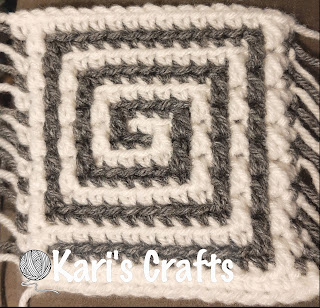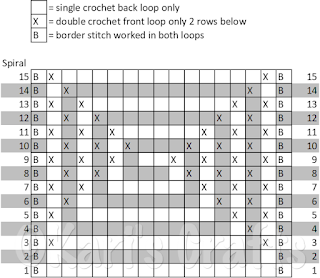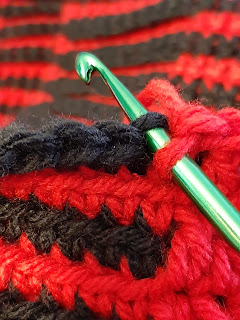Here is another practice graph for Overlay Mosaic Crochet. This is a good size to practice the technique as well as making a small gauge swatch. It also makes a great coaster!
You can use any yarn you like with an appropriate crochet hook for the yarn. The sample shown was crocheted with Red Heart Super Saver yarn in White for color A and Grey Heather for color B with a size H/5mm hook. I get a gauge of 14 stitches x 14 rows = 4" in pattern with this hook and yarn.
As a reminder, border stitches are single crochet stitches worked into both loops. Except for the border stitches, all single crochet stitches are worked into the back loop only of the stitch in the previous row. All double crochet stitches are worked into the front loop only of the stitch two rows below. Fasten off at the end of each row.
Written Instructions:
Row 0 (foundation row): Make 17 foundation sc or chain 18, sc in 2nd chain from hook and in each chain across (17 sc)
Row 1 (color A): sc, 15 scblo, sc
Row 2 (color B): sc, 15 scblo, sc
Row 3 (color A): sc, 1 dcflo, 13 scblo, 1 dcflo, sc
Row 4 (color B): sc, 1 scblo, 13 dcflo, 1 scblo, sc
Row 5 (color A): sc, 1 dcflo, 13 scblo, 1 dcflo, sc
Row 6 (color B): sc, 1 scblo, 3 dcflo, 7 scblo, 3 dcflo, 1 scblo, sc
Row 7 (color A): sc, 1 dcflo, 3 scblo, 7 dcflo, 3 scblo, 1 dcflo, sc
Row 8 (color B): sc, 1 scblo, 3 dcflo, 7 scblo, 3 dcflo, 1 scblo, sc
Row 9 (color A): sc, 1 dcflo, 3 scblo, 3 dcflo, 1 scblo, 3 dcflo, 3 scblo, 1 dcflo, sc
Row 10 (color B): sc, 1 scblo, 3 dcflo, 7 scblo, 3 dcflo, 1 scblo, sc
Row 11 (color A): sc, 1 dcflo, 3 scblo, 7 dcflo, 3 scblo, 1 dcflo, sc
Row 12 (color B): sc, 1 scblo, 3 dcflo, 7 scblo, 3 dcflo, 1 scblo, sc
Row 13 (color A): sc, 1 dcflo, 13 scblo, 1 dcflo, sc
Row 14 (color B): sc, 1 scblo, 13 dcflo, 1 scblo, sc
Row 15 (color A): sc, 1 dcflo, 13 scblo, 1 dcflo, sc








